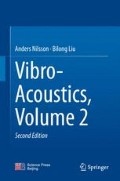Abstract
A waveguide is a system, which by means of its boundaries contains and directs the flow of energy in a construction. One such system is a structural waveguide typical of a ship construction. Aircraft and certain train constructions are also built up of frames and plates. Parallel frames mounted to plate elements guide the propagation of waves in a direction of the frames. A sandwich or honeycomb plate forms another type of waveguide. The laminates coupled to a core contain the energy flow in the structure. A third type of a waveguide system is a cylinder.
Access this chapter
Tax calculation will be finalised at checkout
Purchases are for personal use only
Author information
Authors and Affiliations
Corresponding author
Problems
Problems
14.1
Determine the first five cut-on frequencies for an acoustic cylindrical waveguide.
14.2
A structural waveguide, Fig. 14.2, is excited by a bending moment \(M\exp (i\omega t)\) at \(x = 0\). The bending moment is constant along the y-axis. Determine the energy flow in the waveguide. The plate element is simply supported along the lines \(y = 0\) and \(y = L_y \). Assume the waveguide to be semi-infinite.
14.3
Assume that the elements in Fig. 14.5 are beam elements. Determine the coupling elements in the matrix \(\left[ A \right] \) of Eq. (14.23) for this particular case.
14.4
Use Eq. (14.34) to prove the results given in Eq. (14.36).
14.5
Determine the matrix giving the natural frequencies of a sandwich beam with free ends.
14.6
Determine the response of a simply supported sandwich beam, length L, mass per unit length \({m}'\), and bending stiffness \({D}'\). The beam is extended along the x-axis of a coordinate system from \(x = 0\) to \(x = L\). The beam is excited by a force \(F\exp (i\omega t)\) at \(x_1 \) where \(0 < x_1 < L\).
14.7
Determine the point mobility of an infinite sandwich beam.
14.8
Determine the high frequency limits for the wavenumbers for waves propagating on a circular cylinder.
14.9
Use Eq. (14.100) to predict the sound transmission loss of a curved panel for \(f > f_\mathrm{c}\) and well above the ring frequency.
14.10
Show that in a finite circular cylinder with an inside over pressure \(\Delta p\) the tensions \({T}'_x \) and \({T}'_y \) are approximated by \({T}'_x = \Delta pR_y / 2\) and \({T}'_y = \Delta pR_y \).
Rights and permissions
Copyright information
© 2016 Science Press, Beijing and Springer-Verlag Berlin Heidelberg
About this chapter
Cite this chapter
Nilsson, A., Liu, B. (2016). Waveguides. In: Vibro-Acoustics, Volume 2. Springer, Berlin, Heidelberg. https://doi.org/10.1007/978-3-662-47934-6_14
Download citation
DOI: https://doi.org/10.1007/978-3-662-47934-6_14
Published:
Publisher Name: Springer, Berlin, Heidelberg
Print ISBN: 978-3-662-47933-9
Online ISBN: 978-3-662-47934-6
eBook Packages: Physics and AstronomyPhysics and Astronomy (R0)

